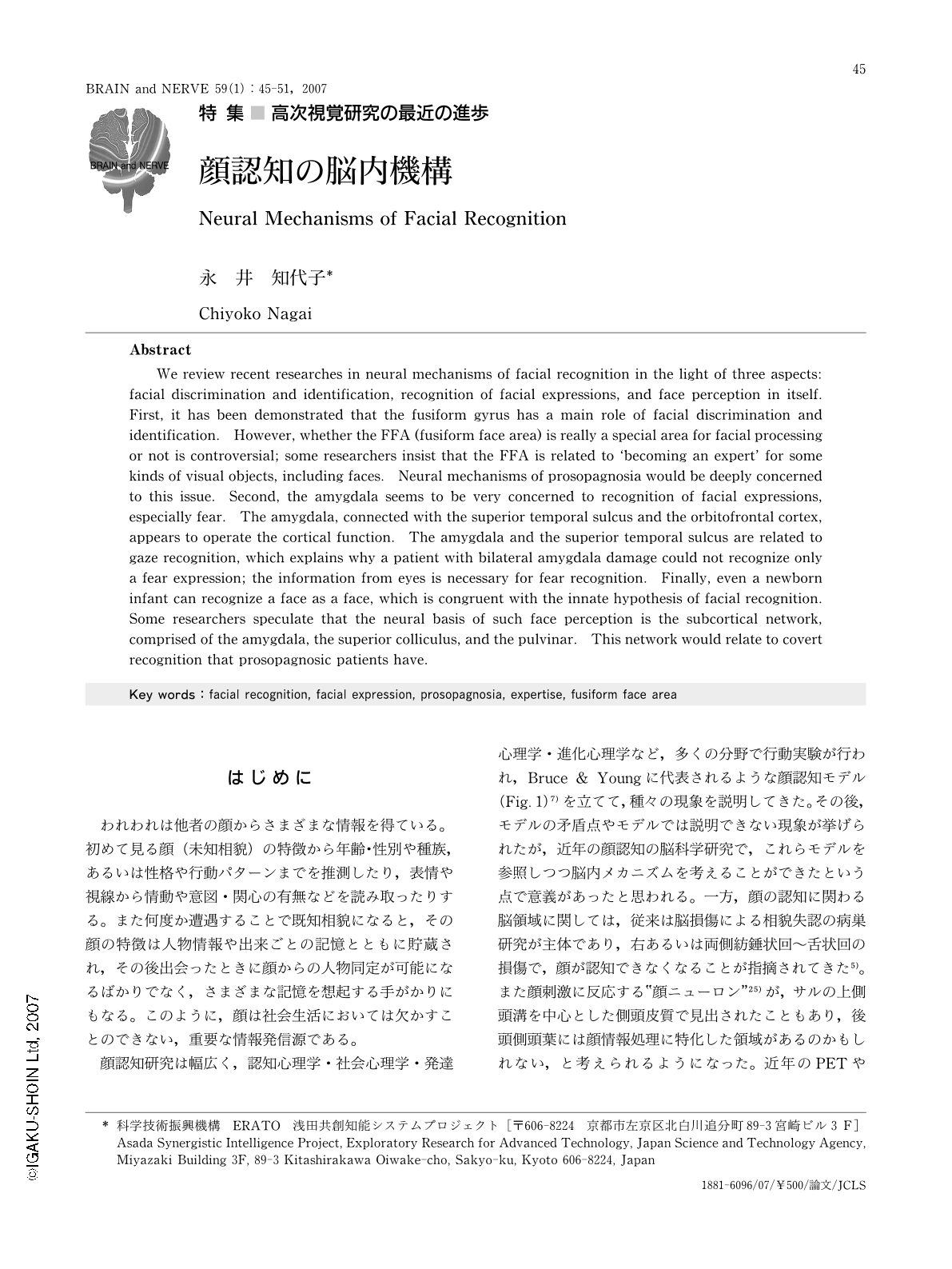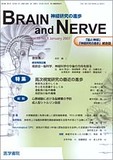Japanese
English
- 有料閲覧
- Abstract 文献概要
- 1ページ目 Look Inside
- 参考文献 Reference
はじめに
われわれは他者の顔からさまざまな情報を得ている。初めて見る顔(未知相貌)の特徴から年齢・性別や種族,あるいは性格や行動パターンまでを推測したり,表情や視線から情動や意図・関心の有無などを読み取ったりする。また何度か遭遇することで既知相貌になると,その顔の特徴は人物情報や出来ごとの記憶とともに貯蔵され,その後出会ったときに顔からの人物同定が可能になるばかりでなく,さまざまな記憶を想起する手がかりにもなる。このように,顔は社会生活においては欠かすことのできない,重要な情報発信源である。
顔認知研究は幅広く,認知心理学・社会心理学・発達心理学・進化心理学など,多くの分野で行動実験が行われ,Bruce & Youngに代表されるような顔認知モデル(Fig.1)7)を立てて,種々の現象を説明してきた。その後,モデルの矛盾点やモデルでは説明できない現象が挙げられたが,近年の顔認知の脳科学研究で,これらモデルを参照しつつ脳内メカニズムを考えることができたという点で意義があったと思われる。一方,顔の認知に関わる脳領域に関しては,従来は脳損傷による相貌失認の病巣研究が主体であり,右あるいは両側紡錘状回~舌状回の損傷で,顔が認知できなくなることが指摘されてきた5)。また顔刺激に反応する“顔ニューロン”25)が,サルの上側頭溝を中心とした側頭皮質で見出されたこともあり,後頭側頭葉には顔情報処理に特化した領域があるのかもしれない,と考えられるようになった。近年のPETやfMRIなどの機能イメージング研究はこの領域を明らかにしたが,逆に,顔の情報処理に関わるのは側頭後頭葉だけではなく,いわゆる“ソーシャルブレイン(扁桃体-上側頭回-眼窩回)”6)や皮質下構造を含む広い領域であることをも明らかにしてきている。
顔認知研究において常に論点となるのは,顔は視覚対象として特殊なのかどうか,また顔情報処理を専門とする特殊な脳機構があるのかどうかという問題であり,これらは密接に結びついていると思われる。本稿では,相貌失認の行動学的特徴を参照しつつ,顔認知の諸相,すなわち①人物の同定や弁別,②表情認知,③顔であることの知覚,に関する近年の研究を紹介していく。
Abstract
We review recent researches in neural mechanisms of facial recognition in the light of three aspects:facial discrimination and identification, recognition of facial expressions, and face perception in itself. First, it has been demonstrated that the fusiform gyrus has a main role of facial discrimination and identification. However,whether the FFA (fusiform face area)is really a special area for facial processing or not is controversial; some researchers insist that the FFA is related to ‘becoming an expert’for some kinds of visual objects, including faces. Neural mechanisms of prosopagnosia would be deeply concerned to this issue. Second, the amygdala seems to be very concerned to recognition of facial expressions, especially fear. The amygdala, connected with the superior temporal sulcus and the orbitofrontal cortex, appears to operate the cortical function. The amygdala and the superior temporal sulcus are related to gaze recognition, which explains why a patient with bilateral amygdala damage could not recognize only a fear expression; the information from eyes is necessary for fear recognition. Finally, even a newborn infant can recognize a face as a face, which is congruent with the innate hypothesis of facial recognition. Some researchers speculate that the neural basis of such face perception is the subcortical network, comprised of the amygdala, the superior colliculus, and the pulvinar. This network would relate to covert recognition that prosopagnosic patients have.

Copyright © 2007, Igaku-Shoin Ltd. All rights reserved.


